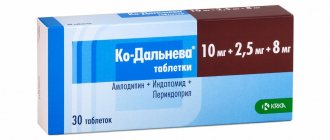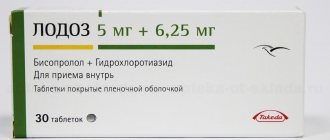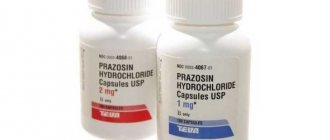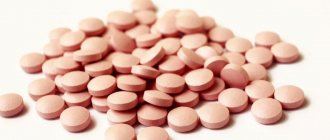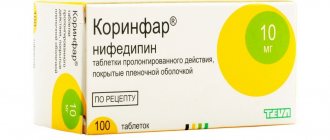Hypertension is a disease that is difficult to diagnose immediately. The first signs of hypertension are increased blood pressure, weakness and pain in the head. If signs of hypertension appear, you should consult a doctor who will prescribe drug therapy. Diuretics are used to treat hypertension. When taking Indapamide for blood pressure, a pronounced diuretic effect is observed. The medication lowers blood pressure, improves general condition, and removes water from the body.
Brief information about the drug
Indapamide is a diuretic prescribed for hypertension. The drug lowers blood pressure, improves general condition and has minimal side effects and contraindications. You can take the drug only as prescribed by your doctor after examination and collection of tests. The medication is taken as a course. The duration of the course and treatment regimen are prescribed individually by the attending physician.
Release form and packaging
The drug Indapamide is produced in the form of tablets and capsules. Convex white tablets have a round shape. In the middle there is a risk for dividing the dosage. Orange capsules are film-coated.
Each tablet is packaged in an individual blister cell. One pack contains 30 tablets. Capsules are sold in polymer jars or contour blisters with cells. There are 30 pieces in a package. The drug comes with instructions for using Indapamide.
Packaging of Indapamide
Composition of tablets
The main active ingredient of the drug is Indapamide. One tablet contains 2.5 mg of the substance.
Other components of Indapamide tablets:
- microcrystalline cellulose;
- lactose monohydrate;
- magnesium stearate;
- talc;
- potato starch;
- sodium glycolate;
- titanium dioxide;
- hydroxypropyl methylcellulose;
- polysorb;
- dyes.
Price and conditions for dispensing from a pharmacy
Indapamide blood pressure tablets are sold in pharmacies with a prescription from your doctor. The price for Indapamide is 500 rubles.
Storage rules
The blood pressure medication should be stored in a place protected from children at a temperature not exceeding 25 degrees.
The shelf life of the drug is 2 years from the date of manufacture. After the expiration date, the drug cannot be used; it must be disposed of in accordance with sanitary standards.
Instructions for use
The most basic indication for the use of Indapamide will be therapeutic measures for essential arterial hypertension. It is sold freely in pharmacies (no prescription in Latin is needed), and only specialists prescribe this remedy.
This drug is a diuretic in type, its structure is similar to that of a thiazide diuretic. The product has a specific composition:
- copovidone;
- lactose monohydrate;
- magnesium stearate;
- hypromellose;
- anhydrous colloidal silicon dioxide.
Thanks to it and the unique mechanism of operation, this drug reduces blood pressure, although the volume of urine excreted does not increase in any way. Most of all, the medicine affects the renal and vascular tissues.
The antihypertensive effect is pronounced even when taking small doses of the drug.
The product has a high lipophilicity, so it helps to change the degree of membrane permeability for ions of different elements. This reduces the intensity of contraction of smooth muscles and vessel walls.
Standardly, Indapamide is available in the form of tablets with 1.5 mg of active ingredient. There are packs with different numbers of contour packs. The total number of tablets in a package usually does not exceed 30 pieces.
The cost for 1 pack can range from 100 to 300 rubles
, the price depends on the number of blisters and the specific pharmacy.
There are analogue products with an increased amount of the base component, there is 2.5 mg of it. Such drugs are a little more expensive and their price tag can reach up to 500 rubles.
How does the product work?
WE RECOMMEND THE ARTICLE!
Spironolactone and Veroshpiron should be taken for edema that develops against the background of heart failure. Read more >>
Why is Indapamide or Indapamide Retard prescribed in terms of pharmacological effect? Thanks to its comprehensive mechanism of action, the drug lowers blood pressure without causing diuresis. In the nephron tubules, the reabsorption of ions is blocked:
- hydrogen;
- potassium;
- chlorine;
- sodium
As a result, the permeability of the membrane to these ions decreases. The reactive function of the vascular walls in relation to angiotensin and norepinephrine decreases, the production of prostaglandins increases (they further dilate the blood vessels), and the flow of Ca into smooth muscles is inhibited.
The effect of the product can last up to a day after a single use. A pronounced and sustained antihypertensive effect begins to develop at the end of 1 and beginning of 2 weeks
treatment.
Dosage
The maximum you can consume is up to 2.5 mg of Indapamide per day (this is 1 tablet). The product should be taken in the morning before meals; the tablet should not be chewed. Usually the course of treatment lasts up to 8 weeks.
This drug is contraindicated for children under 18 years of age, since the effect of indapamide on them has not been fully studied.
If a positive result is not observed as a result of treatment, you cannot increase the dose yourself.
This is due to the fact that the intensity of the antihypertensive effect will not increase, but the diuretic effect will appear. At high concentrations of the drug in the body, unwanted side effects may begin to bother you. In such situations, drugs against arterial hypertension that do not have a diuretic effect are prescribed.
In elderly patients, therapy is carried out taking into account several indicators:
- age;
- floor;
- body mass.
Depending on these parameters, the number of doses per day and the maximum dosage vary. Indapamide is suitable for patients with normal or moderately impaired renal function.
In case of an overdose of the drug, patients may develop various skin rashes, disturbances in the psychoemotional state, dysfunction of the cardiovascular, reproductive systems and gastrointestinal tract. The consequences are neutralized by stopping the drug. In patients who took Indapamide according to the doctor's recommendations, no such side effects were observed.
Important features of therapy
When carrying out treatment with Indapamide, several rules must be followed. These include:
- You cannot stop taking other medications. This refers to drugs against hypertension. If a specialist prescribes a set of tablets, it means that all of them are needed for mutual support of the body or to ensure the result of the drug’s action.
- Before stopping the drug or reducing the dosage, it is better to consult a specialist.
- Breaks of a day or two during the treatment course are unacceptable.
- After starting therapy, for the first 4 days you need to limit yourself from potentially dangerous work and driving.
Additionally, each patient is recommended to undergo a blood test to examine the level of creatine, potassium and other components. All conditions for treatment with the drug are mandatory.
Pharmacokinetic characteristics
The blood pressure medication is taken orally. After entering the stomach, the drug is quickly absorbed. Bioavailability is 93%. Eating food simultaneously with the medication reduces the rate of absorption of the components. The maximum concentration is reached 1-2 hours after taking the tablet. The results from taking the drug are consolidated after a week of regular therapy.
The half-life of the components is 18 hours. Metabolites bind to blood proteins by 70-80%. The components of the drug penetrate into breast milk and through the placental barrier.
Metabolites are formed in the liver and excreted by the kidneys.
Mechanism of action of diuretics in hypertension
Pharmacodynamics and pharmacokinetics
The drug “Indapamide”, which has a diuretic effect on the body in case of arterial hypertension, has the following effect:
- hypotensive;
- reduces the overall resistance exerted by capillaries on the blood flow;
- relaxes the walls of blood vessels;
- prevents ventricular hypertrophy;
- removes fluid from the body.
Diuretics
The desired medicinal effect from Indapamide tablets can be achieved either by taking the drug exactly in accordance with the doctor’s instructions, or by following the instructions. Under such conditions, the duration of taking Indapamide can be long. If you increase the dosage, you will not be able to achieve a greater hypotensive effect from the tablets.
The drug does not react with fats and carbohydrates, so diabetes and high cholesterol are not a contraindication to taking Indapamide. It is also recommended for people who have had a kidney transplant or undergoing hemodialysis.
After taking blood pressure tablets, they increase salt ions in the urine (sodium, potassium, magnesium, chlorine). The substance perfectly strengthens the walls of blood vessels, increases their elasticity and reduces permeability, lowering the overall peripheral resistance. “Indapamide” activates the production of prostaglandin E-2, which is responsible for removing tone and relaxing tissue.
After administration, the drug is quickly absorbed in the stomach, with up to 93% of the substance entering the blood, the result is observed within 24 hours. Absorption begins after half an hour. The action lasts up to 12 hours - it is after this period of time that the maximum concentration of indapamide is in the blood, and food intake does not affect this process in any way.
The half-life of the drug is 18 hours, 80% of the process is carried out by the kidneys, the remaining 20% is taken over by the intestines.
Pharmacodynamic features
Indapamide tablets are classified as thiazide diuretics. The drug Indapamide has a positive effect on the body:
- reduces blood pressure through a diuretic effect;
- reduces arterial resistance;
- reduces peripheral vascular resistance;
- dilates blood vessels;
- controls the increase in the mass of the left ventricular myocardium;
- has a moderate diuretic effect.
The drug Indapamide blocks calcium channels, increases the elasticity of the arteries, and reduces vascular resistance.
The tablets do not affect the level of lipids in the blood and carbohydrate metabolism. If the concentration of potassium in the blood is low, the drug may increase glucose levels.
Diuretic effect of the drug
Indapamide tablets for blood pressure are diuretics with a mild effect. This is a thiazide diuretic that removes excess water from the body and improves the general condition of a patient with hypertension. To reduce blood pressure with Indapamide, a minimum daily dose is sufficient.
Diuretic effect of Indapamide:
- frequent urination;
- dilatation of renal vessels;
- normalization of blood circulation;
- relieving tissue swelling.
In combination, the diuretic effect of Indapamide has a positive effect on blood pressure. When taken regularly, Indapamide lowers blood pressure, reduces the load on the heart, and reduces the likelihood of developing a heart attack and stroke.
At what pressure should I take it?
Recommendations for taking tablets are indicated in the instructions for use of Indapamide. The drug is prescribed to patients with a history of hypertension. Hypertension must be confirmed clinically. Before prescribing the blood pressure medication Indapamide, the doctor conducts a comprehensive examination, collects tests, and draws up a general picture of the disease.
Indapamide should not be taken if there are occasional surges in blood pressure. If a person with hypotension takes the medicine, his condition will greatly worsen.
The medication is prescribed to patients with a persistent, regular increase in blood pressure above 140 to 90 mm Hg. Art.
The medicine is prescribed for persistently high blood pressure
Side effects
Taking the diuretic drug Indapamide can cause a number of side effects (the full list is listed in the instructions for use).
- Leather. Rashes in the form of urticaria, itching, burning, purpura, photodermatosis.
- Allergic reactions. Quincke's edema, anaphylactic shock (rare).
- CNS. Dizziness and headaches, increased nervousness, muscle aches, temporary weakness, vertigo.
- Gastrointestinal tract. Nausea, rarely turning into vomiting, liver dysfunction, exacerbation of pancreatitis, temporary retention of stool.
- Heart, blood vessels. Increased heart rate, orthostatic hypotension.
- Lungs and respiratory system. Dry cough, sinusitis, pharyngitis (very rare).
- Other. Anemia, leukopenia, hypercalcemia, hypokalemia, increased concentrations of creatinine and urea.
Note! If adverse reactions occur or there are contraindications, it is necessary to replace Indapamide with antihypertensive drugs with a different principle of action (Perindopril, Losartan, Kokor and others).
Who is contraindicated for taking pills?
The medication is well tolerated by patients, despite the impressive list of contraindications.
Contraindications to taking Indapamide for high blood pressure:
- severe kidney failure;
- liver dysfunction;
- cerebrovascular accidents;
- primary lactase deficiency;
- hypolactasia;
- increased levels of uric acid in the blood;
- gout;
- increased susceptibility to the components of the drug;
- children under 18 years of age;
- pregnancy;
- lactation;
- increased potassium levels in the blood.
Doctors prescribe the drug with caution for mild forms of renal and liver dysfunction, diabetes, and osteitis fibrocystis.
Contraindications
When taking indapamide, you should pay attention to the list of contraindications; the drug may be harmful to some. Do not take Indapamide tablets if:
- there is chronic renal failure, liver dysfunction, hypersensitivity to the components of the drug (both active and auxiliary);
- the patient has not reached the age of majority;
- anuria is observed;
- a woman is carrying a child or breastfeeding;
- there is hypokalemia, metabolic disorders, decreased blood supply to brain cells;
- signs of a pre-infarction state appear.
For patients who use medications for heart failure, laxatives due to excessive adrenal gland activity, and for elderly people, the use of Indapamide tablets must be carried out under the supervision of a doctor. He should regularly check the electrolyte levels in his blood and urine.
People with liver disease, ischemia, and chronic heart disease also need medical supervision. Patients with diabetes need to constantly monitor changes in blood sugar levels. Patients with lupus erythematosus may notice an exacerbation of the symptoms of the disease.
When indicated, Indapamide is taken throughout a person’s life.
Taking Indapamide tablets can cause the following problems and abnormalities in the body:
- increased manifestations of lupus erythematosus;
- dry cough;
- pharyngitis and sinusitis;
- runny nose;
- hives;
- itching;
- rash on the body;
- hyperaldosteronism;
- vascular vasculitis;
- decreased blood pressure;
- tachycardia and arrhythmia;
- low level of potassium ions in the blood;
- lead to frequent inflammatory processes in the genitourinary system;
- polyuria and nocturia;
- nausea and vomiting;
- disorders of the gastrointestinal tract;
- a feeling of dry mouth and loss of taste;
- pain and discomfort in the abdominal area;
- kidney encephalopathy;
- inflammation of the pancreas;
- drowsiness, weakness, fatigue;
- vertigo syndrome and headaches;
- irritability and anxiety;
- glucosuria;
- hypercreatinimia;
- hemolytic anemia;
- bone marrow damage;
- decrease in leukocytes in the blood;
- metabolic alkolosis;
- thrombocytopenia.
The drug is prescribed by a doctor taking into account contraindications
How to take Indapamide correctly for hypertension
You can take Indapamide for high blood pressure only as prescribed by a doctor. Indapamide tablets are taken orally, regardless of meal time. Doctors recommend taking the medicine in the morning. Do not chew, dissolve or crush the tablets. For hypertension, you need to drink Indapamide whole, with a sufficient amount of drinking water.
The minimum daily dose is 2.5 mg. It is enough to drink 1 Indapamide tablet per day. In the absence of a therapeutic effect, you cannot independently increase the dosage of Indapamide, as this will not affect blood pressure readings.
The drug has a cumulative effect, so the first improvements may appear after 7-14 days.
If there is no effect from taking the medication for a long time, you should consult a doctor who will select another method of treatment.
Indapamide is taken with a doctor's prescription
Composition and release form
We will talk about contraindications and side effects of Indapamide below. In the meantime, let’s figure out what’s in the medication.
It comes in several forms:
- Capsules, which are packaged in blister packs of 5, 6, 7, 10, 30 pcs. or in jars of 10, 20, 30, 40, 50, 100 pcs.
- Long-acting coated tablets - in blisters of 10 pcs. or 30 pcs. in banks.
- Modified-release coated tablets – in blister packs of 10 and 14 pcs.
This medicine contains an active element – indapamide. Auxiliary components of the capsules are: magnesium stearate, microcrystalline cellulose. Additional substances in the tablets: hypromellose, lactose monohydrate, magnesium stearate, colloidal anhydrous silicon dioxide, polyethylene glycol, croscarmellose sodium, crospovidone, povidone K30, talc, sodium lauryl sulfate. It is important to find out the contraindications of Indapamide in advance.
Important Notes and Recommendations
Taking the blood pressure drug Indapamide can cause Liebmann-Sachs disease. This is a chronic disease that results in the appearance of red spots on the skin. Athletes are not recommended to take Indapamide if they have high blood pressure on the eve of competitions, as they may give a false reaction during doping control.
Other recommendations for taking Indapamide blood pressure tablets:
- if the concentration of calcium in the blood plasma increases, it is worth checking the thyroid gland, as this indicates hyperthyroidism;
- taking Indapamide tablets can lead to the development of a hyperreaction of the skin to sunlight, then the use of the drug for the treatment of hypertension is discontinued;
- during the course of taking Indapamide, it is necessary to protect the skin from direct sunlight and ultraviolet radiation;
- when undergoing Indapamide therapy, it is necessary to monitor blood counts and electrolyte levels;
- During therapy with Indapamide, it is necessary to monitor the level of glucose, uric acid, and non-protein nitrogen in the blood;
- Before prescribing the drug Indapamide for hypertension, the doctor must conduct a comprehensive examination, establish the clinical picture of the disease, and exclude disturbances in water and electrolyte metabolism.
Elderly patients need to monitor serum creatinine levels.
The blood pressure drug Indapamide should not be taken by women during pregnancy and breastfeeding. The components of the tablets penetrate the placental barrier and into breast milk.
During the course of taking the drug Indapamide for blood pressure, you must refrain from driving vehicles and performing work that requires increased concentration and speed of psychomotor reactions.
Indapamide is not prescribed to pregnant women
Interaction
Simultaneous use of saluretic, glycoside agents, hormonal substances, amphotericin in the form of injections and laxatives with Indapamide tablets increases the likelihood of a side effect in the form of hypokalemia.
In addition, glycosides taken simultaneously with Indapamide may increase the risk of digitalis poisoning.
Interaction with calcium supplements and metformin can increase the level of lactic acidity in the gastrointestinal tract.
In combination with lithium drugs, the content of substance ions in the blood and its effect on the kidneys increases.
Use with Indapamide tablets, Astemizole, Erythromycin, Pentamidine, Sultopride, drugs that normalize heart rhythm of the first and third classes, can increase heart contractions.
NSAIDs and hormonal drugs will reduce the effectiveness of tablets for hypertension, and when taking baclofen, the effect of indapamide improves.
Potassium-sparing diuretics in combination with indapamide for blood pressure may have a positive effect in some cases, but the risk of hyperkalemia increases, especially against the background of diabetes and kidney disease.
ACE blockers when taking blood pressure pills can cause a sharp drop in blood pressure and lead to acute renal failure.
Drug interactions
Therapy with iodine-containing drugs can lead to dehydration. Antidepressants increase the effect of Indapamide and can therefore cause hypotension. Cyclosporine promotes the development of elevated creatinine levels.
The effect of muscle relaxants under the influence of indapamide improves.
Possible adverse reactions
Taking Indapamide to lower blood pressure can lead to the development of adverse reactions in the body:
- systemic lupus erythematosus;
- cough;
- runny nose;
- inflammation of the pharynx;
- itching;
- burning;
- nettle fever;
- allergic purpura;
- increased heart rate;
- heart rhythm disturbance;
- orthostatic collapse;
- infectious diseases of the urinary system;
- sleep disorders;
- vestibular disorders;
- headache;
- dizziness;
- prostration;
- asthenic syndrome;
- depression;
- muscle spasms;
- unreasonable feelings of anxiety;
- apathy;
- increased irritability;
- aplasia of hematopoiesis;
- decrease in the number of leukocytes;
- decreased platelet count;
- decreased sodium levels;
- glycosuria;
- lack of potassium;
- excess calcium.
Interaction with other drugs and overdose
There are a number of drugs with which Indapamide cannot be taken. These include:
- Cyclosporine. It can cause the development of hypercreatininemia.
- Erythromycin. Taking these two drugs together causes tachycardia with ventricular fibrillation.
- Iodine-containing drugs lead to water-electrolyte imbalance.
- Cardiac glycosides and the use of laxatives develop potassium deficiency in the body.
- Non-steroidal drugs reduce the pharmacological effect of Indapamide.
- Antidepressants increase the hypotensive effect.
As the daily dose of the drug increases, patients develop overdose symptoms. They manifest themselves in the following form: nausea and vomiting, weakness and malaise, malfunction of the gastrointestinal tract, disturbance of water-electrolyte balance, and a sharp decrease in blood pressure. First aid for signs of overdose is gastric lavage, the use of symptomatic therapy and correction of water and electrolyte balance.
Drug interactions
The blood pressure medicine Indapamide cannot be combined with a number of other medications:
- cyclosporines: leads to an increase in creatinine levels in the blood;
- antibiotic Erythromycin: causes heart palpitations;
- iodine-containing drugs: causes a lack of fluid;
- saluretics, laxatives, cardiac glycosides: reduces the concentration of potassium in the blood;
- non-steroidal anti-inflammatory drugs, glucocorticoids: reduce the antihypertensive effect;
- neuroleptic and psychotropic drugs: increase the hypotensive effect.
The drug Indapamide reduces the effectiveness of indirect anticoagulants, and also enhances neuromuscular blockade when taking anticholinergics.
Method of use of the drug for hypertension
The treatment regimen must be selected by a doctor; incorrect treatment can lead to disastrous results. For high blood pressure, Indapamide is prescribed once a day. It is recommended to drink in the morning on an empty stomach or after breakfast. Admission rules:
- Use the product at the same time, so that there is a 24-hour interval between doses.
- Swallow the medicine whole without chewing.
- Drink plenty of water.
- Change the dosage or stop the course of treatment only with your doctor's permission.
In hypertensive crises requiring immediate reduction of blood pressure, Indapamide cannot be used. In such cases, resort to other diuretics
The prolonged effect of the drug is associated with its gradual dissolution. If you crush the tablets or pour out the contents of the capsules before taking them, the active substance will be instantly absorbed into the tissues and cause a sharp drop in blood pressure.
This condition leads to disruption of all body systems. The duration of treatment with Indapamide depends on the patient's condition. Typically it ranges from several weeks to several months. When the pressure stabilizes, the drug is discontinued.
Alcohol compatibility
The blood pressure drug Indapamide should not be taken simultaneously with alcohol. When taking a course, you must completely abstain from alcohol. Taking Indapamide tablets together with alcohol can lead to the development of undesirable reactions:
- allergy;
- drowsy state;
- lethargy;
- muscle pain;
- swelling;
- hormonal imbalance;
- difficulty defecating;
- indigestion;
- loss of appetite;
- increased nervous excitability;
- heart rhythm disturbance;
- increased heart rate;
- dry skin;
- dyspnea;
- LVH.
With a course of taking the drug Indapamide and alcohol abuse, the load on the heart and blood vessels increases.
Drinking alcohol during treatment with Indapamide may lead to adverse effects
Restrictions on use
Like every medicine, Indapamide also has its contraindications for use, so before taking Indapamide, it is recommended to read the instructions. The diuretic is intended only for patients with high blood pressure. If a patient with hypotension starts taking the drug, his general condition will sharply worsen.
Also, taking the drug should be limited to people with the following problems:
Magnesia for high blood pressure
- renal failure;
- cerebrovascular accident;
- lactose deficiency;
- hypokalemia.
The drug should be taken with caution in patients with decompensated diabetes mellitus. During the entire course of treatment, they need to monitor their blood sugar levels. Particular caution in use is also required in case of failure of water-electrolyte balance and an increase in the QT interval on the ECG.
Side effects
With long-term use of Indapamide, you may encounter side effects, which are divided according to frequency of occurrence and group of manifestations. Side effects may occur in the following body systems:
- respiratory;
- cardiovascular;
- digestive;
- neurological;
- excretory;
- hematopoietic abnormalities;
- others.
Side effects on the central nervous system include dizziness, irritability, insomnia, loss of sensitivity, and muscle tension. Vascular abnormalities - signs of hypokalemia on the ECG, rhythm disturbances, sharp decrease in pressure (orthostatic). When taking a diuretic drug, a change in the blood picture may occur: a decrease in platelets, granulocytes (resulting in a decrease in leukocytes), red blood cells (with the development of anemia).
Side effects from the respiratory system manifest themselves as inflammation of structures (bronchitis, sinusitis, pharyngitis). The kidneys respond to the medicine by predominant night urine over daytime urine, as well as an increase in fluid volume.
From the digestive tract, symptoms such as nausea, vomiting, stool disturbances, lack of appetite, weight loss, and stomach pain are likely. In addition to these groups of disorders, exacerbation of systemic lupus erythematosus, decreased vision, potency and desire may be observed. If individual components are intolerant, urticaria, Quincke's edema, and skin itching may appear over a long period of time.
Price
The drug package is designed for 1 month of use and contains 30 tablets. How much Indapamide blood pressure tablets cost depends on the country of origin and the rate of absorption of the active ingredient. For example, a Serbian product costs 96 rubles, a Russian one – 95 rubles, and an Israeli one – 122 rubles. Therefore, what type of drug to purchase depends on the financial capabilities of the patient. Perhaps the most expensive and cheapest drugs will be equally effective.
The difference in price is also due to the quality of the raw materials. The more expensive the medicine, the fewer impurities in the finished drug, the better the degree of purification of the primary mixture. The cost of Indapamide also includes the cost of transporting the goods. This means that the cost may be comparable, but a diuretic from the USA will be 2 times more expensive than from Russia.
When choosing the best drug, you need to rely on the doctor’s recommendations.
Doctors' recommendations
Now we will look at several recommendations from doctors related to the use of tablets and capsules.
- If treatment lasts more than one month and no positive effect is achieved, then the dosage prescribed by the doctor should not be exceeded. An alternative to this is changing the treatment plan.
- Indapamide is a complex treatment drug; other medications can be taken with it.
- To improve the effect, know: the best time to use the medicine is in the morning; it is better to do it in the morning, on an empty stomach.
The above recommendations from doctors will help enhance the therapeutic effect.


